Symmetry can be split into two mirror-image halves. Suppose you can fold any picture, in it half you see both sides match, it is called Symmetrical. The word “symmetry” comes from a Greek word that implies measuring together. The two objects are claimed to be symmetrical if they have an identical size and shape with one object having a different orientation from the first. You are already acquainted with the term symmetry which is a balanced and proportionate similarity found in two halves of an object, one – half is the mirror image of the other half.
Line of Symmetry – Introduction
Line of symmetry means, it is the line that passes through the center of the object or any shape and it is considered as the imaginary or axis line of the object. Another name of line symmetry is “Reflection symmetry”, one half is the reflection of the other half. Reflection symmetry sometimes called line symmetry or Mirror symmetry. The line of symmetry can be in any direction.
For example, if we cut an equilateral triangle into two equal halves, then the two triangles are formed after the intersection is the right-angled triangles. Take one more example, if we cut an orange into two equal halves, then one of the pieces is said to be in symmetry with another. Rectangle, circle, square are also considered examples of line symmetry.
Line of Symmetry – Definition
Line of symmetry is defined as, a line that cuts a shape exactly in half, if you fold the shape or figure along the line, both halves would match exactly that is symmetrical halves. It is also termed as Axis of symmetry. The line symmetry also called a reflection symmetry or mirror symmetry because it presents two reflections of an image that can coincide.
A line of symmetry may be one or more lines of symmetry. Symmetry has many types such as
- Infinite lines of symmetry
- One line of symmetry
- Two lines of symmetry
- Multiple lines of symmetry (more than two lines is called multiple lines)
- No line of symmetry means the figure is asymmetrical.
There are many shapes that are irregular and cannot be divided into equal parts. Such shapes are termed asymmetrical shapes. Hence, in such cases, line symmetry is not applicable. Line of symmetry are two types:
- Vertical line of symmetry
- Horizontal line of symmetry
Also, Read:
Types of Line of Symmetry
Basically, the line of symmetry is of two types. The line or axes may be any combination of Vertical, Horizontal, and Diagonal. Two types of lines of symmetry are
- Vertical line of symmetry
- Horizontal line of symmetry
Vertical Line of Symmetry
A vertical line of symmetry refers to one which runs down an image or figure and divides into two identical halves. The mirror image of the other half of the shape can be seen in a vertical or straight standing position. A, H, M, O, U, V, W, T, Y are some of the alphabets that can be divided vertically in symmetry. The trapezoid has only the vertical line of symmetry.
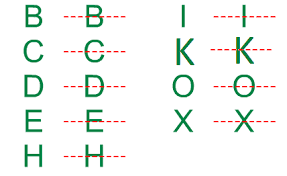
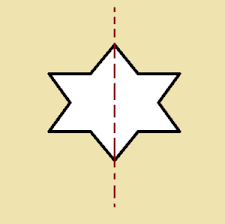
Horizontal Line of Symmetry
The Horizontal line of symmetry is a line or axis of a shape which runs across the image, it divides into two identical halves is known as the Horizontal Line of Symmetry. B, C, H, E, are some of the alphabets that can be divided horizontally in symmetry.

 Some other types of lines of symmetries are there. Those are three lines of symmetry, four lines of symmetry, five lines of symmetry, six lines of symmetry, and infinite lines of symmetry.
Some other types of lines of symmetries are there. Those are three lines of symmetry, four lines of symmetry, five lines of symmetry, six lines of symmetry, and infinite lines of symmetry.
Three Lines of Symmetry
An Equilateral Triangle has about three lines of symmetry. It is symmetrical along its three medians.

Four Lines of Symmetry
A square has four lines of symmetry. It can be folded in half over either diagonal, the horizontal segment which cuts the square in half, and the vertical segment which cuts the square in half. so, the square has four lines of symmetry.
A square is symmetrical along four lines of symmetry, two along the diagonals and two along with the midpoints of the opposite sides. some other patterns also have four lines of symmetry.
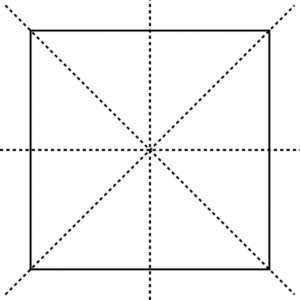 Five Lines of Symmetry
Five Lines of Symmetry
A regular pentagon has around five lines of symmetry. The lines joining a vertex to the mid-point of the opposite side divide the figure into ten symmetrical halves. Some other patterns also have five lines of symmetry.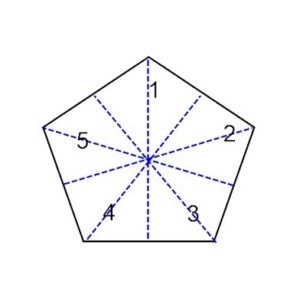
Six Lines of Symmetry
A regular polygon with N sides has N lines of symmetry. Hexagon is said to have six lines of symmetry, 3 joining the opposite vertices and 3 joining the midpoints of the opposite sides.
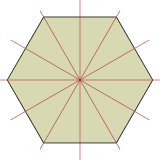
Infinite Lines of Symmetry
A circle has its diameter as the line of symmetry, and a circle can have an infinite number of diameters. It is symmetrical along all its diameters.
Examples of Lines of Symmetry
Line of Symmetry has different figures and we have outlined few examples
- A Triangle is said to have 3, 1 number lines of symmetry
- A quadrilateral has 4 or 2 number lines of symmetry
- An Equilateral Triangle has 3- lines of symmetry
- A Regular Pentagon has 5lines of symmetry
- A Regular Heptagon has 7 lines of symmetry
- A circle has an infinite number of lines of symmetry
Real-Life Examples of Lines of Symmetry
- Reflection of trees in clear water.
- Reflection of mountains in a lake.
- Most butterflies’ wings are identical on the left and right sides.
- Some human faces are the same on the left and right.
- People can also have a symmetrical mustache.
FAQ’s on Line of Symmetry
1. How many lines of symmetry does a circle have?
A circle has infinite lines of symmetry.
2. What is the figure of reflection symmetry on a vertical mirror?
A rectangle is the figure of reflection symmetry on a vertical mirror.
3. Define Line of Symmetry?
The imaginary line or axis along which you can fold a figure to obtain the symmetrical halves is called the line of symmetry. It is also termed the axis of symmetry. The other names of Line of Symmetry are Reflection Symmetry or Mirror Symmetry.
4. What are the types of Lines of Symmetry?
Lines of Symmetry are of two types, the first one is the Vertical line of symmetry and the second one is the Horizontal line of symmetry.
5. Define Vertical Line of Symmetry?
The axis of the shape or object or figure which divides the shape into two identical halves Vertically is called a Vertical line of symmetry.
6. Define Horizontal Line of Symmetry?
The axis of the shape or figure or object that divides the shape into two identical halves Horizontally is called a horizontal line of symmetry.
